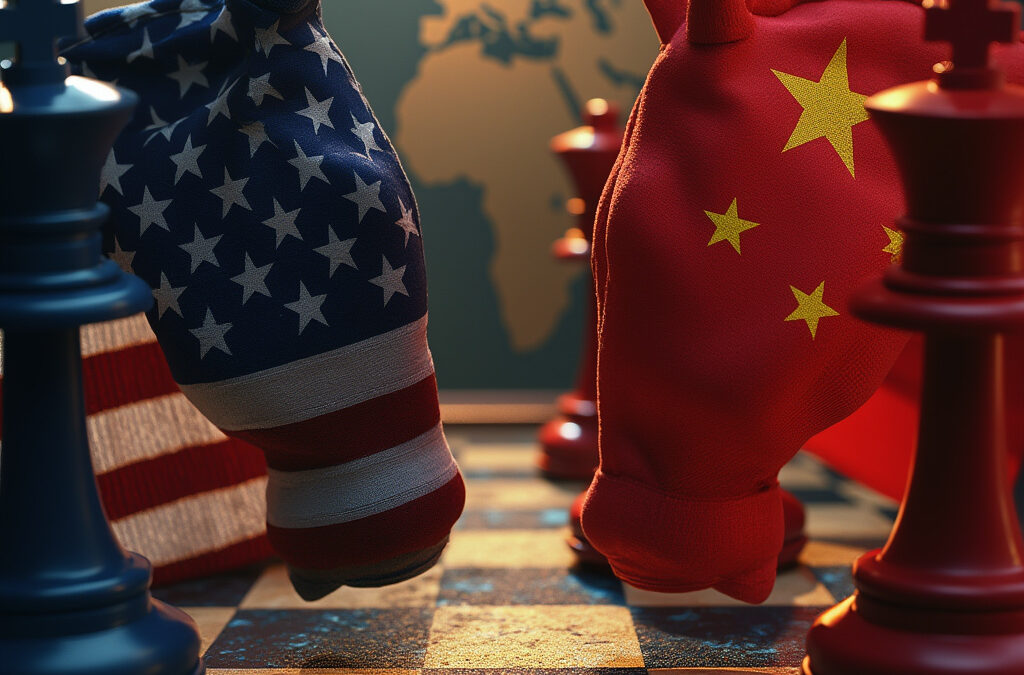Trump’s Tariffs and Immediate Retaliation
The global trade landscape has reached a boiling point as the U.S., China, and the European Union engage in an escalating cycle of tariffs and economic retaliation. At the center of this storm is President Donald Trump, whose administration has imposed sweeping tariffs on imports from key trading partners.
The latest round of U.S. tariffs has drawn sharp responses from both China and the EU. In a move that marked a significant escalation, the Trump administration introduced a 104% tariff on certain Chinese goods. This was later adjusted, with “reciprocal” tariffs set at 10% for many nations, while Chinese imports faced a higher rate of 125%. Trump defended these measures as necessary to counter what he described as China’s exploitation of global markets.
China wasted no time in responding. Beijing raised its tariffs on U.S. goods from 34% to 84%, signaling its resolve to stand firm against American trade policies. In a strongly worded statement, Chinese officials condemned the U.S. tariffs as a “mistake upon a mistake,” accusing the Trump administration of unilateralism and economic bullying. China also expanded its “unreliable entities” list, adding 11 U.S. companies and restricting their access to dual-use goods. Unlike the EU, China made it clear that any future dialogue would require mutual respect and equality.
The European Union, another key target of Trump’s tariffs, announced its own retaliatory measures. The bloc imposed tariffs on $22 billion worth of U.S. goods, targeting products such as soybeans, motorcycles, and beauty products. EU officials criticized the U.S. tariffs as unjustified and detrimental to the global economy. While the EU expressed a willingness to negotiate, its actions suggest a preparedness for a prolonged trade war.
Deepening Economic Rifts and Global Market Impact
The escalating trade conflict has led to a significant deepening of economic rifts between the major global powers. China’s decision to add 11 U.S. companies to its “unreliable entities” list has further strained relations, effectively cutting off their access to dual-use goods. This move underscores Beijing’s determination to counter what it perceives as aggressive U.S. trade policies. Chinese officials have emphasized that any future negotiations must be based on mutual respect and equality, signaling a hardening stance in the face of U.S. tariffs.
The European Union, while also imposing retaliatory tariffs on $22 billion worth of U.S. goods, has adopted a slightly different approach. Unlike China, the EU has expressed a willingness to engage in dialogue, though its actions suggest a preparedness for a prolonged trade war. The bloc’s tariffs target a wide range of U.S. products, including soybeans, motorcycles, and beauty products, in a bid to exert pressure on the Trump administration to reconsider its trade policies.
The global economy has begun to feel the ripple effects of these retaliatory measures. Businesses worldwide are grappling with increased costs, disrupted supply chains, and heightened uncertainty. The trade war has also sparked concerns about its long-term impact on economic growth, with many analysts warning of a potential slowdown in global trade volumes. As tensions continue to escalate, the international community is bracing for further economic fallout.
Conclusion
The escalating trade tensions between the U.S., China, and the European Union have reached a critical juncture, with each side imposing retaliatory tariffs and hardening their stances. President Trump’s aggressive tariff policies have sparked a global trade war, leading to significant economic rifts and disruptions in international markets. China’s decision to expand its “unreliable entities” list and impose higher tariffs on U.S. goods reflects its determination to counter what it views as unfair trade practices. Similarly, the EU’s retaliatory measures, though slightly more measured, demonstrate its commitment to protecting its economic interests.
The global economy is already feeling the ripple effects of this trade conflict, with businesses facing increased costs, supply chain disruptions, and heightened uncertainty. As tensions continue to escalate, the international community is bracing for further economic fallout. The path forward remains uncertain, with no clear resolution in sight. Whether the involved parties can negotiate a mutually beneficial agreement or opt for prolonged confrontation will shape the future of global trade for years to come.
Frequently Asked Questions
What tariffs has the Trump administration imposed on Chinese goods?
The Trump administration initially imposed a 104% tariff on certain Chinese goods, which was later adjusted to 10% for many nations, while Chinese imports faced a higher rate of 125%.
How did China respond to the U.S. tariffs?
China raised its tariffs on U.S. goods from 34% to 84% and expanded its “unreliable entities” list, adding 11 U.S. companies and restricting their access to dual-use goods. Chinese officials emphasized that future negotiations must be based on mutual respect and equality.
What retaliatory measures did the European Union take?
The EU imposed tariffs on $22 billion worth of U.S. goods, targeting products such as soybeans, motorcycles, and beauty products. While the EU expressed a willingness to negotiate, its actions suggest preparedness for a prolonged trade war.
What has been the impact of the trade war on the global economy?
The trade war has led to increased costs, disrupted supply chains, and heightened uncertainty for businesses worldwide. There are concerns about its long-term impact on economic growth and global trade volumes.
What is the outlook for resolving the trade conflict?
The outlook remains uncertain, with no clear resolution in sight. The involved parties will need to negotiate a mutually beneficial agreement to avoid further economic fallout and prolonged confrontation.

